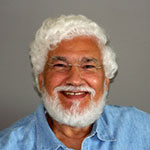April 17, 2019
Our first image of a black hole: Is it the beginning of a new era of discovery?
Does the first recorded image of a black hole mean we're almost at the end of what science can discover? The short answer is: No.
But perhaps the question we should be asking is: Are there fundamental limits to what we humans using our brains can discover?
As far as we know, we are the only creatures capable of discovering not only ourselves, but also the vast universe around us. No other plants, insects, animals, birds, bacteria, no matter what degree of individual or collective sentience they seem to possess, can do the same. Nor can cosmically-formed bodies, such as planets, stars, comets and the virtually infinite number of galaxies in which they form a remarkable pattern of existence.
As far as we have learned through our self-awareness and intellect, humans are unique in their capability to grow from one discovery to another, about themselves and about the universe at large.
But that uniqueness comes with a twist – actually, with multiple twists.
First, our ability to discover ourselves and the universe in which we live carries with it huge ethical and social responsibilities.
Second, we must humbly accept that whoever, or whatever, designed us and our seemingly infinite universe represents genius beyond our furthest imaginings.
Third, even in the flush of excitement over historic events such as the first-ever black hole image, we must always bear in mind that what we know so far is infinitesimal, compared to what we do not yet know.
Fourth, we must also recognize that the universe is a far more complex structure than we are.
Fifth, what we humans have claimed to “invent” down through history is not true invention, but the concrete application of what we have discovered.
Sixth, the applied sciences that have produced numerous hardware and software tools over the years, including AI applications, merely mimic the universe and our human brain.
Seven, while discovering new wonders in deep space, we are far from fully understanding the greatest mystery of all – how our human brains work. In fact, we’re not even close.
Back to the recent black hole photo.
On April 10, 2019 the Event Horizon Telescope (EHT) – a global collaboration of unprecedented size and exactitude – produced the first image of a super black hole at the core of the massive elliptical galaxy M-87.
The image shows a ghostly bright crescent surrounding a black circle, the most gravitationally extreme region known: this is the black hole’s “event horizon” or visible boundary, past which nothing can escape from being swallowed up.
Back in 1905, Einstein’s theory of general relativity predicted that a mass can become sufficiently compacted to deform space-time, thus forming a black hole. Black holes exhibit such strong gravitational effects that nothing, not even tiny particles, or electromagnetic radiation such as light, can break free. Yet despite being defined so precisely, black holes were long considered a mathematical curiosity.
But by testing Einstein’s theories right at the edge of a black hole’s event horizon, the EHT has provided physicists with the ultimate laboratory in which to better understand gravity, the fundamental force driving the formation of stars, planets, and the evolution of our universe.
Black holes originate when massive stars collapse at the end of their life cycles. Once formed, they continue to grow by absorbing mass from their surroundings. For this reason, supermassive black holes exist at the core of most galaxies.
Once we truly understand the force of gravity, the impact could be revolutionary, according to EHT team member Prof. Avery Broderick of the University of Waterloo and Perimeter Institute for Theoretical Physics. “Gravity is the key scientific problem facing physics today, and no one fully understands the ramifications of what understanding gravity fully are going to be.”
Supermassive black holes are purveyors of both creation and doom, as they have the power to kick-start star formation, as well as preventing stars from forming at all. Astronomers hope to use the EHT to better understand this cosmic dichotomy.
“These incredibly massive things lie at the centers of galaxies and rule their fates,” says Broderick. “Supermassive black holes are the engines behind active galactic nuclei and distant quasars, the most energetic objects known. Now we’re seeing what they look like, up close, for the first time.”
The massive black hole at the center of our own Milky Way galaxy is called Sagittarius A* (or Sgr A*) and is 2,000 times less massive than the one photographed in M-87. But at a modest interstellar distance of just 25,000 light-years, it’s also 2,000 times closer.
This means that the EHT can image both Sgr A* and M-87 as they appear approximately the same size in the sky, an incredibly fortunate situation for researchers.
While M-87’s supermassive black hole is one of the largest known, “a real mover and shaker,” Sgr A* is much smaller, more like an “everyman of black holes,” Broderick noted.
“We had to start somewhere,” he continued. “M-87 represents the first end-to-end exercise of the entire EHT collaboration – from data taking to data interpretation. The next exercise will happen considerably faster. This is only the beginning.”
And a wonderful beginning it is, as we humans mark a new liminal edge in our quest to further understand ourselves and our universe.








